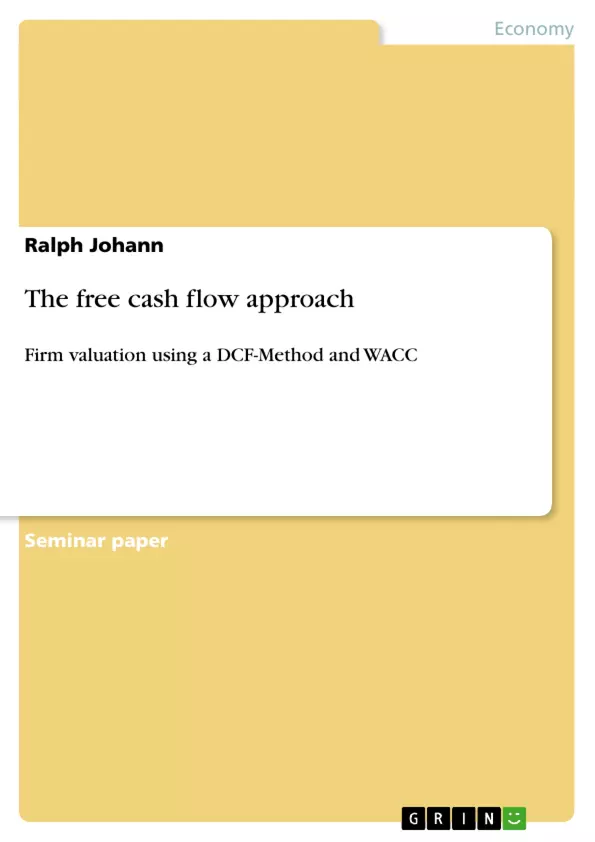This paper will deal with the procedure and implementations of firm/stock valuation using FCF approach and WACC – the weighted average cost of capital. On the road, the different approaches and methods of firm valuation, the various inputs of WACC and the final procedure finding the fair market value of the firm using Pro Forma Financial Statements, will be discussed. In this valuation method the two main parts contributing to the final value of the
firm are Free Cash Flows (FCF) and the weighted average cost of capital. It is then used the time value of money concept along with some educated guesses about the long term sales growth rate and the long term WACC to apply common capital budgeting rules of project evaluation.
Besides that, the paper will shortly discuss the influence of capital structure on a firm’s value. It will come out that there is a difference in value whether the company is leveraged and uses debt or not. When it comes to the different inputs of the WACC, a main focus will be on the required rate of return for shareholders. Finding the ‘right’ beta and an appropriate estimate for the market risk premium are the main issues of that part. Therefore, the CAPM model and its specific determinants will be analyzed. Thereafter, the nature of pro forma financial statements and the different parts of them will be defined. It will be described how the ‘free cash flows’ are determined and how that leads to the actual valuation procedure. Finally, the paper will focus on
the terminal value as probably the most important and affecting part of the calculated firm value and its nature as a perpetuity in an investing perspective. The conclusion will finally deal with a critical assessment of the firm valuation process with the FCF method.
Inhaltsverzeichnis (Table of Contents)
- Introduction
- Reasons for firm valuation
- Firm valuation methods
- Weighted Average Cost of Capital (WACC)
- The Cost of Equity Capital: Major considerations and its calculation using CAPM
- Estimating the Risk-Free Rate
- The Concept of Beta
- Estimating the Market Risk Premium
- Alternatives to CAPM
- Cost of Debt and the Weighted Average Cost of Capital (WACC)
- The Free Cash Flow Approach
- Firm Value determination using the FCF/DCF Approach
- AFN calculation - a byproduct of Pro Forma Financial Statements
- Scenario Analysis with Monte Carlo Simulation
Zielsetzung und Themenschwerpunkte (Objectives and Key Themes)
This paper presents a comprehensive analysis of firm valuation using the Free Cash Flow (FCF) approach and the Weighted Average Cost of Capital (WACC). It explores the methodology and implementation of this valuation method, emphasizing the role of Pro Forma Financial Statements in calculating the fair market value of a firm. The paper also delves into the cost of equity capital, analyzing the Capital Asset Pricing Model (CAPM) and its determinants.- Firm valuation methodologies and their practical application
- The role of Free Cash Flows (FCF) and WACC in determining firm value
- Calculating the cost of equity capital using CAPM and its various inputs
- The application of Pro Forma Financial Statements in firm valuation
- The influence of capital structure on firm value
Zusammenfassung der Kapitel (Chapter Summaries)
The first chapter introduces the concept of firm valuation and explores its importance for both management and investors. It outlines the different valuation methods used in practice, including the Price-Earnings (P/E) approach and the Dividend Valuation Model (DVM). Chapter two focuses on the Weighted Average Cost of Capital (WACC), analyzing the cost of equity capital, particularly its calculation using the Capital Asset Pricing Model (CAPM). This chapter delves into the critical elements of CAPM, such as the risk-free rate, beta, and the market risk premium. It also explores alternative methods to CAPM for estimating the cost of equity. Finally, the chapter concludes with a discussion of the cost of debt and its incorporation into the WACC calculation. Chapter three explores the Free Cash Flow (FCF) approach to firm valuation, outlining the procedure for determining firm value using FCF and the discounted cash flow (DCF) method. This chapter also details the process of calculating the additional funds needed (AFN) and the use of pro forma financial statements. It further examines the application of scenario analysis with Monte Carlo simulation for incorporating uncertainty in firm valuation.Schlüsselwörter (Keywords)
The key themes and concepts explored in this paper revolve around firm valuation, specifically using the Free Cash Flow approach and the Weighted Average Cost of Capital. The paper delves into the details of the Capital Asset Pricing Model (CAPM), examining its various components like risk-free rate, beta, and market risk premium. It further highlights the importance of Pro Forma Financial Statements in calculating the fair market value of a firm. The paper also touches upon the relationship between capital structure and firm value, particularly the impact of leverage on firm valuation.- Citar trabajo
- Ralph Johann (Autor), 2005, The free cash flow approach, Múnich, GRIN Verlag, https://www.grin.com/document/114406



